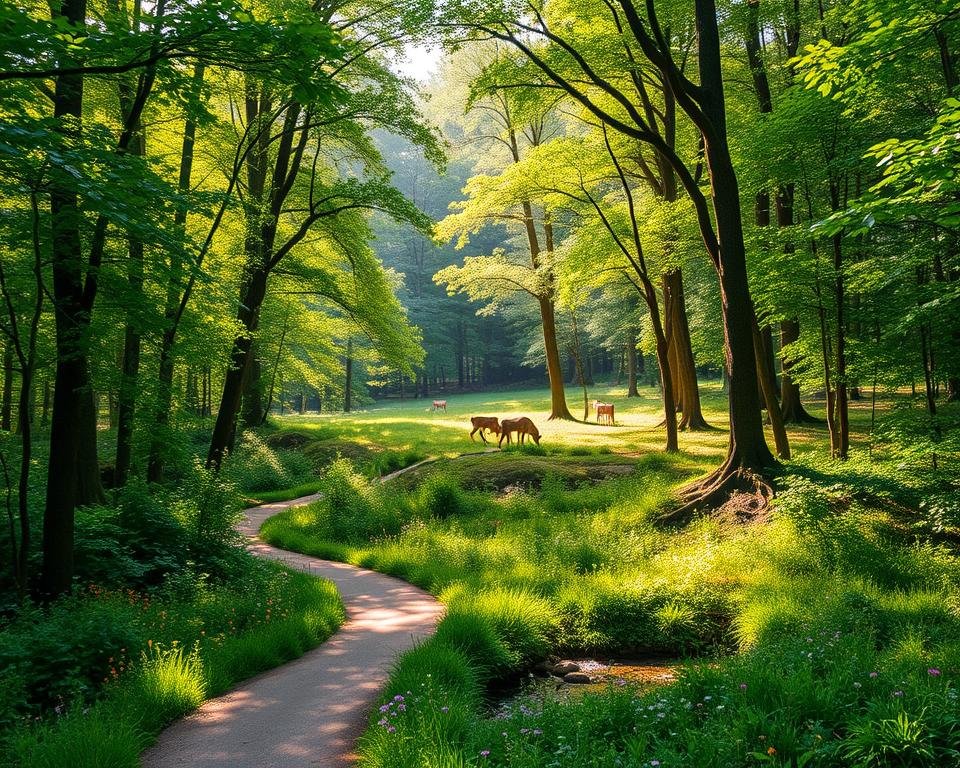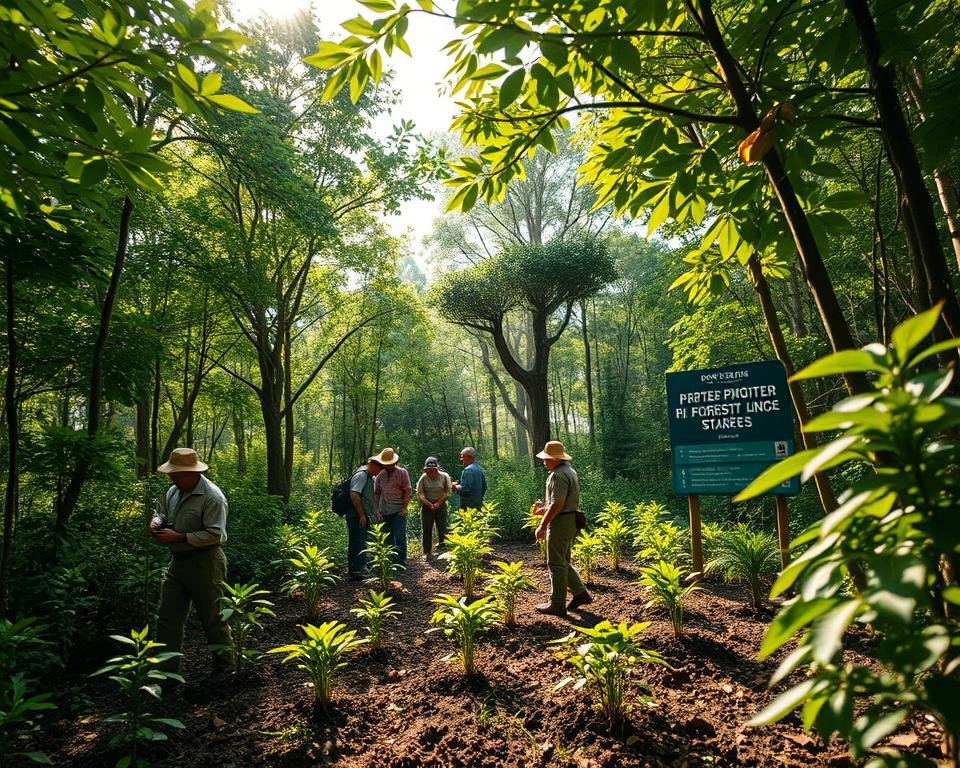Anúncios
Did you know that forests cover about 30% of the Earth’s land? Yet, they are home to more than 80% of the world’s terrestrial species. This shows how crucial forests are for life on Earth. Let’s dive into the amazing world of forest diversity and learn about the complex ecosystems within.
Anúncios
These ecosystems give us many benefits. They provide clean air and water, help keep soil healthy, and control the climate. These are all key ecosystem services we need. By understanding their value, we can see why we must protect them.
Key Takeaways
- Forests are home to a vast array of plant and animal life.
- Ecosystem services provided by forests are vital for ecological balance.
- Conserving forest diversity is key to keeping these services.
- Human actions affect forest ecosystems, impacting biodiversity.
- Knowing about forest ecosystems helps us in conservation efforts.
What is Forest Biodiversity?
Forest biodiversity is key to healthy forests. It supports life on Earth by providing essential ecosystem services. It includes various plants, animals, fungi, and microorganisms, along with their genetic diversity.
Definition and Importance
Forest biodiversity keeps ecosystems in balance. It offers services like air and water purification, soil formation, and climate regulation. Without it, ecosystems would struggle to survive.
Anúncios
It’s not just about the number of species. It also includes the genetic diversity within those species and the variety of ecosystems. This broad view helps us understand forest ecosystems better.
Key Components of Biodiversity
The main parts of forest biodiversity are:
- Species Richness: The number of different species in a forest.
- Ecosystem Variety: The different types of ecosystems in a forest, like various forest types or wetlands.
- Genetic Diversity: The variety of genes within a species, helping it adapt to changes.
Knowing these parts is vital for conservation efforts. It helps conservationists create effective plans to protect and boost forest biodiversity.
The Role of Forests in Ecosystems
Forests play a key role in keeping our environment stable and supporting biodiversity. They are complex systems that offer many essential services for life on Earth.
Habitat for Wildlife
Forests are home to a wide variety of wildlife, including plants, animals, and microorganisms. The canopy and forest floor give shelter, food, and places to breed for many species. Habitat degradation from human activities like deforestation threatens these species.
For example, deforestation impacts harm local biodiversity and affect nutrient cycles and climate. This shows the wide reach of habitat loss.
“Forests are the most biodiverse ecosystems on land, hosting a vast array of plant and animal species. Their preservation is critical for global biodiversity.”
Carbon Sequestration
Forests are vital for carbon sequestration. They absorb carbon dioxide through photosynthesis and store it in trees and soil. This helps fight climate change by lowering greenhouse gases.
| Forest Type | Carbon Storage Capacity | Role in Climate Regulation |
|---|---|---|
| Tropical Forests | High | Significant carbon sink, supports high biodiversity |
| Temperate Forests | Moderate to High | Important for regional climate regulation |
| Boreal Forests | High | Critical for global carbon storage, influences global climate patterns |
The table shows different forests have different carbon storage abilities. It stresses the need to protect and manage all forests sustainably.
Threats to Forest Biodiversity
Our forests face many dangers that harm their balance. It’s key to know these challenges to protect forest biodiversity.
Deforestation
Deforestation is a big threat to forests. It happens when humans cut down trees for farming, building, and logging. This destroys homes for animals, causes soil to erode, and releases more greenhouse gases. Sustainable forestry practices help fight deforestation.
- Loss of habitat for countless species
- Increased risk of soil erosion
- Contribution to climate change through the release of stored carbon
Climate Change
Climate change is a long-term danger to forests. Warmer temperatures and changing weather patterns change where trees and animals live. This disrupts the balance of forest ecosystems, making them more fragile.
- Shifts in species distribution
- Increased frequency of extreme weather events
- Altered forest regeneration patterns
Invasive Species
Invasive species are a big threat too. They can outdo native species for food and space, change how ecosystems work, and even wipe out native species. They can get into forests through human actions and climate change.
| Impact | Description |
|---|---|
| Competition for Resources | Invasive species compete with native species for food, water, and habitat. |
| Ecosystem Alteration | Invasive species can alter fire regimes, nutrient cycling, and other ecosystem processes. |
| Extinction Risk | Native species may face increased risk of extinction due to competition and predation by invasive species. |
We need a wide plan to tackle these dangers. This includes using sustainable forestry practices, fighting climate change, and stopping invasive species. By acting to save forest biodiversity, we protect wildlife diversity and keep our forests healthy for the future.
Benefits of Forest Biodiversity to Humans
Forest biodiversity offers many benefits to humans, from life-saving medicines to eco-tourism. Forests are home to a wide variety of plants and animals. Many of these species are yet to be fully understood or used by humans.
Effective forest management practices are key to keeping forests healthy and biodiverse. By using sustainable management, we can ensure forests keep giving us benefits without losing their health.
Medicinal Resources
Forests are a treasure trove of medicinal plants. Many medicines we use today come from forest plants. For example, the Madagascar periwinkle (Catharanthaus roseus) has given us two important chemotherapy drugs.
“The forest is a laboratory where the greatest diversity of life on Earth is found, and it is here that we can discover new medicines and other products that improve human well-being.”
A study in Nature shows how vital biodiversity is for medical research. Losing species due to habitat loss can mean losing cures for diseases.
| Medicinal Plant | Use | Forest Type |
|---|---|---|
| Madagascar Periwinkle | Cancer Treatment | Tropical |
| Willow Bark | Pain Relief | Temperate |
| Ginkgo Biloba | Memory Enhancement | Temperate |
Recreation and Tourism
Forests also offer many opportunities for recreation and tourism. Activities like hiking, camping, and wildlife watching bring joy and help us appreciate nature.

By managing forests in a way that balances human use with conservation, we can keep them healthy for the future. This includes sustainable tourism that doesn’t harm the environment.
- Eco-tourism initiatives can support local communities.
- Recreational activities promote physical and mental health.
- Conservation efforts are enhanced through community engagement.
In conclusion, the benefits of forest biodiversity to humans are vast and varied. By focusing on effective forest management practices, we can enjoy these benefits while protecting forest ecosystems.
Major Forest Types in the United States
The United States has many different forests, like temperate, tropical, and boreal. Each type has its own biodiversity and ecosystem services.
Temperate Forests
Temperate forests have seasons and are in areas with mild weather. They are full of deciduous trees that lose their leaves each year. This creates a thick layer of leaves that many plants and animals live in.
- These forests are home to many animals, like deer and birds.
- They help the environment by storing carbon and cleaning water.
- People often cut down trees here for wood, but they try to do it in a way that doesn’t harm the forest.
Tropical Forests
Tropical forests are rare in the mainland U.S. but can be found in Hawaii and Puerto Rico. These forests are rich in biodiversity. They have many different plants and animals that live in the warm, wet weather.
- Tropical forests are key for global biodiversity, with many unique species.
- They help control the climate by storing carbon.
- But, they face dangers like invasive species and climate change.
Boreal Forests
Boreal forests, or taiga, are in Alaska. They have a very cold climate. The forests are mostly coniferous trees like spruce and fir, which can handle the cold.
- Boreal forests are big carbon sinks, holding lots of carbon dioxide.
- They are home to animals like bears and moose that can handle the cold.
- But, they are also affected by climate change, as the weather gets warmer.
Knowing about these forest types is key to managing them well. This helps keep their biodiversity and ecosystem services safe for the future.
The Importance of Conservation Efforts
As we face environmental challenges, conservation efforts are key. Forests are vital for biodiversity and fighting climate change. We must protect these ecosystems for the future.
Protected Areas and Reserves
Creating protected areas and reserves is a major conservation strategy. These zones protect many plants and animals from harm. They help keep forest ecosystems balanced.
The U.S. Forest Service says protected areas are vital for conservation. They preserve biodiversity and support research, education, and fun activities. Here are some benefits of these areas:
| Benefits | Description |
|---|---|
| Biodiversity Preservation | Protects a wide range of species and their habitats |
| Research Opportunities | Facilitates scientific studies and monitoring |
| Recreation and Tourism | Offers opportunities for eco-tourism and outdoor activities |
Community Involvement in Conservation
Getting local communities involved in conservation is also important. They can help manage and protect forests. This makes conservation efforts more effective and lasting.
“Community-led conservation initiatives have shown remarkable success in preserving forest ecosystems. By empowering local communities, we can ensure the long-term protection of these vital resources.”

In summary, conservation is essential for forest biodiversity. By creating protected areas and working with local communities, we can ensure a sustainable future for our forests.
How Forest Biodiversity Supports Climate Resilience
Forests with lots of different species are more ready for climate change. They have many types of life and ecosystems. This helps them stay strong and adapt to new conditions.
Ecosystem Stability
Ecosystem stability is key for fighting climate change. Forests with lots of species richness are more stable. They can handle problems and bounce back faster.
This stability keeps forests healthy and working well, even with climate change. It also helps with many important ecological processes. For instance, diverse forests keep nutrient cycles going, support wildlife, and prevent soil erosion.
Mitigation of Extreme Weather
Forests help a lot with extreme weather. They soak up rain and stop floods and landslides. They also cool the air, making cities cooler.
But, habitat degradation can hurt these benefits. When forests are damaged or split up, they can’t help as much. So, it’s important to protect forests to keep them supporting us against climate change.
| Ecosystem Service | Benefit to Climate Resilience | Impact of Habitat Degradation |
|---|---|---|
| Ecosystem Stability | Enhances ability to withstand climate change | Reduced stability, increased vulnerability |
| Mitigation of Extreme Weather | Reduces impact of flooding and heatwaves | Increased risk of flooding and landslides |
Innovative Approaches to Enhance Biodiversity
In our effort to save biodiversity, new methods like agroforestry are proving very effective. These methods help keep nature in balance and offer many benefits to both the planet and people.
Agroforestry
Agroforestry mixes trees into farms, boosting nature’s teamwork. It makes complex systems that support many species. Agroforestry systems also improve soil, reduce erosion, and increase biodiversity.
Agroforestry has many advantages. It can make crops grow better because of better soil and climate. It also helps fight climate change by capturing carbon dioxide.
Reforestation Projects
Reforestation projects are key to boosting biodiversity. They fix damaged forests, giving homes to animals and fighting deforestation. Reforestation efforts help ecosystems heal, save biodiversity, and improve services.
| Project Type | Biodiversity Impact | Ecosystem Benefits |
|---|---|---|
| Agroforestry | Increases species diversity | Soil conservation, carbon sequestration |
| Reforestation | Restores habitats for wildlife | Climate regulation, water cycle maintenance |
By using these new ways, we can greatly improve biodiversity and nature’s health. It’s vital to keep finding and using such strategies to fight deforestation and climate change.
Engaging Communities in Biodiversity Preservation
Getting communities involved is key to saving biodiversity. By working with local people, we can support sustainable forestry and better forest management practices. This effort not only protects nature but also boosts the local economy and improves people’s lives.
Education and Awareness Campaigns
Education and awareness are vital for teaching communities about biodiversity. We use workshops, social media, and local events to spread the word. This helps people make choices that help save nature.
For example, we teach about the good of sustainable forestry practices. This includes keeping forests healthy, helping wildlife, and ensuring forests last long. When people understand these benefits, they can live in harmony with nature.
Citizen Science Opportunities
Citizen science lets people help with biodiversity research. It makes them feel like they own the effort. By joining, people learn to collect data, identify species, and assess habitats.
| Benefits of Citizen Science | Description |
|---|---|
| Enhanced Community Engagement | Community members become actively involved in biodiversity conservation. |
| Improved Data Collection | Citizen science projects contribute to a broader understanding of biodiversity trends. |
| Educational Opportunities | Participants learn about biodiversity, ecology, and conservation practices. |
By teaching, raising awareness, and using citizen science, we can improve sustainable forestry and forest management practices. This teamwork is vital for saving our forests for the next generations.
Future Trends in Forest Biodiversity Research
Forest biodiversity research is set to see big changes with new tech and more global teamwork. These steps will help us understand forests better and find ways to protect them.
Advancements in Research Methods
New tech like remote sensing and genetic analysis is changing forest research. These tools help us watch over ecosystem services and get a better grasp of forest life.
Global Initiatives for Conservation
Working together worldwide is key to saving forests. By joining forces, we can tackle big challenges and keep forests healthy. Sharing knowledge and coordinating efforts are essential for forest protection.
